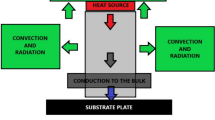Abstract
Coaxial laser material deposition (also known as laser-cladding process) is being used for selective material deposition on complex parts since the 1990s. Its main applications include coatings, rapid manufacturing, or high added value part repairing. The main advantages of the coaxial laser-cladding process are the high-quality bonding interface between added and substrate material, excellent mechanical behavior, and high precision of the resulting geometry in comparison with conventional welding processes. Moreover, the laser-cladding process involves low-heat input, which leads on minimum thermal distortions and reduced heat-affected zone. Thus, high responsibility components like aeronautic turbine parts, tooling for die and mold industry or medical implants, among others, can be processed with laser cladding. This paper presents a laser material deposition process model for the estimation of the geometric characteristics of added material layers, including the prediction of the 3D shape of single and multiple clads and considering overlapping effect, which is the common situation on industrial applications. The model only needs the typical process parameters as the laser power, substrate material, powder material and size, etc. The model has been applied to different laser material deposition strategies and validated for two different materials (AISI D2 and Inconel 718) by experimental testing, obtaining good agreement between estimated and measured values. Finally, a case study for a turbine engine fixture is presented as a possible application. Therefore, the proposed algorithm can be applied for estimating the resulting geometry of the laser-cladding process and predict the optimum laser-cladding strategy, number of layers, and distance between layers before programming the operation.
Similar content being viewed by others
References
Shepeleva L, Medres B, Kaplan WD, Bamberger M, Weisheit A (2000) Laser cladding of turbine blades. Surf Coat Technol 125:45–48
Bendeich P, Alam N, Brandt M, Carr D, Short K, Blevins R, Curfs C, Kirstein O, Atkinson G, Holden T (2006) Residual stress measurements in laser clad repaired low pressure turbine blades for the power industry. Mater Sci Eng, A 437:70–74
Ritcher, K.H., Orban, S., Nowotny, S., 2004. Laser cladding of the titanium alloy Ti6242 to restore damaged blades. Proc. of the 23rd International Congress on Applications of Lasers and Electro-Optics (ICALEO 2004)
Borrego LP, Pires JTB, Costa JM, Ferreira JM (2009) Mould steels repaired by laser welding. Eng Fail Anal 16:596–607
Pinkerton AJ, Li L (2004) The significance of deposition point standoff variations in multiple-layer coaxial laser cladding (coaxial cladding standoff effects). Int J Mach Tools Manuf 44:573–584
Suarez A, Amado JM, Tobar MJ, Yañez A, Fraga E, Peel MJ (2010) Study of residual stresses generated inside laser cladded plates using FEM and diffraction of synchrotron radiation. Surf Coat Technol 204:1983–1988
Chryssolouris G, Zannis S, Tsirbas K, Lalas C (2002) An experimental investigation of laser cladding. CIRP Ann-Manuf Technol 51–1:145–148
Paul CP, Ganesh P, Mishra SK, Bhargava P, Negi J, Nath AK (2007) Investigating laser rapid manufacturing for Inconel-625 components. Opt Laser Technol 39:800–805
Liu CY, Lin J (2003) Thermal processes of a powder particle in coaxial laser cladding. Opti Laser Technol 35:81–86
Fu Y, Loredo A, Martin B, Vannes AB (2002) A theoretical model for laser and powder particles interaction during laser cladding. J Mater Proc Technol 128:106–112
Lalas C, Tsirbas K, Salonitis K, Chryssolouris G (2007) An analytical model of the laser clad geometry. Int J Adv Manuf Technol 32:34–41
Vasquez F, Ramos-Grez JA, Walczak M (2012) Multiphysics simulation of laser–material interaction during laser powder deposition. Int J Adv Manuf Technol 32:34–41
Cho C, Zhao G, Kwak S, Kim C (2004) Computational mechanics of laser cladding process. J Mater Proc Technol 153–154:494–500
Zhao G, Cho C, Kim J (2003) Application of 3-D finite element method using Lagrangian formulation to dilution control in laser cladding process. Int J Mech Sci 45:777–796
Ukar E, Lamikiz A, López de Lacalle LN, Martinez S, Liébana F, Tabernero I (2010) Thermal model with phase change for process parameter determination in laser surface processing. Phys Procedia 5:395–403
Tabernero I, Lamikiz A, Ukar E, López de Lacalle LN, Angulo C, Urbikain G (2010) Numerical simulation and experimental validation of powder flux distribution in coaxial laser cladding. J Mater Proc Technol 210:2125–2134
Tabernero I, Lamikiz A, Martínez S, Ukar E, López de Lacalle LN (2012) Modelling of energy attenuation due to powder flow-laser beam interaction during laser cladding process. J Mater Proc Technol 212:516–522
Author information
Authors and Affiliations
Corresponding author
Rights and permissions
About this article
Cite this article
Tabernero, I., Lamikiz, A., Ukar, E. et al. Modeling of the geometry built-up by coaxial laser material deposition process. Int J Adv Manuf Technol 70, 843–851 (2014). https://doi.org/10.1007/s00170-013-5284-3
Received:
Accepted:
Published:
Issue Date:
DOI: https://doi.org/10.1007/s00170-013-5284-3




